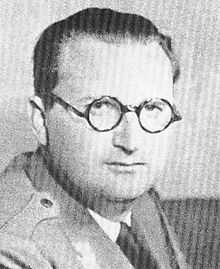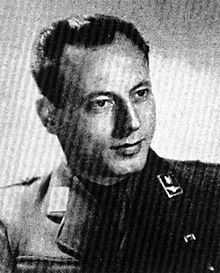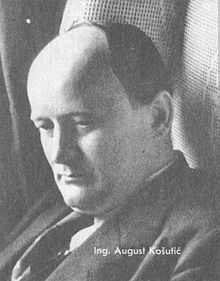Lorković–Vokić plot


Lorković–Vokić plot (Croatian: Urota Lorković-Vokić) was an attempt initiated by the Minister of Interior, Mladen Lorković and Minister of Armed Forces, Ante Vokić, to form a coalition government with the Croatian Peasant Party (HSS), abandon the Axis powers and align the Independent State of Croatia with the Allies with help of the Croatian Home Guard. The plan originated from the HSS which was also involved in the negotiations with the Allies. The plot ended with the massive arrests and execution of major plotters, including Lorković and Vokić.
Situation in Europe

On 24 August 1942, Germans launched an attack on Stalingrad. The Battle of Stalingrad ended in German defeat on 2 February 1943. After this victory, the war was in the Soviet favour.[1] Allied invasion of Sicily was launched on 9 July 1943,[2] and not long after, Benito Mussolini was overthrown and arrested on 25 July.[3] On the same day, Italian king, Victor Emmanuel, named Pietro Badoglio Italy's Prime Minister and on 8 September 1943 he signed the unconditional capitulation of Italy.[4] On 6 June 1944 the Allies launched the Operation Overlord, an invasion of the German-occupied coast of Normandy. The operation is also known as the D-Day.[5]
Coup attempts among the Axis nations
Because of defeats that Axis forces suffered from Allied armies, some Axis nations tried to change sides. On 23 August 1944, as Soviet forces approached Romania, Romanian king, Michael made a coup and joined the Allies. After that Romania was split into two parts, one supporting King Michael and other still supporting the Germans and Ion Antonescu.
Not long after the coup in Romania, Fatherland Front in Bulgaria overthrown the earlier Bulgarian government on 2 September 1944. Three days later, the Soviet Union declared a war on Bulgaria soon occupying the northeastern part of Bulgaria. Bulgarian Army was ordered not to make any resistance. Bulgaria joined the Allies on 8 September 1944.
On 15 October 1944, Hungarian leader Miklos Horthy announced that he had signed an armistice with the Soviet Union. However, the Germans launched Operation Panzerfaust and installed Ferenc Szálasi as leader of Hungary. Even after Horthy announced the armistice, Hungarian soldiers continued to fight the Red Army.
Preparations for the coup

Vladko Maček, the President of the Croatian Peasant Party, thought that the British would support the democratic and anti-communist Croatian state. Because of that, he thought that the Allies would eventually land on the Dalmatian coast and support his party as democratic and anti-communist. He also assumed that the Croatian Home Guard will support the HSS once the invasion of Dalmatia starts. Nevertheless, the Draža Mihailović's Serb-dominated Chetniks had a plan directed against both, Croats and Communists, if the Allied invasion of Dalmatia would occur. The three members of the HSS' leadership, August Košutić, the Vice President; Ljudevit Tomašić, a deputy secretary and representative who was already in contact with the Allies; and Ivanko Farolfi were assigned for negotiations with the British. Farolfi was the most active and was in charge of maintaining contact with the Croatian army officers, party leaders and foreign intelligence services.[6]
Mladen Lorković, had in plan to disarm the German army on the territory of the Independent State of Croatia (NDH), install the Croatian Peasant Party (HSS) into the government and to call all of the Allied armies to land on the territory of the NDH. He also believed that the HSS would prevent the communists or King Peter II to came into power.[7] In July 1944, Vokić held a meeting at which he pointed out that once Allies invade Balkans, the German armed forces must be disarmed. The Germans were aware that Croatia could switch to Allies. The Luftwaffe's attache in Zagreb on 11 August reported that the Croatian military become increasingly uncooperative towards the Germans. He also noted their request for higher amount of arms and ammunition from the German military.[8] Lorković established the contact with the Croatian Peasant Party representatives in Croatia, Ivanko Farolfi, Ljudevit Tomašić and August Košutić.
Their plan about Allied invasion of Dalmatia failed at its beginning, as Allies had no intention to do that. Even so, Winston Churchill was a sympathizer of the Allied invasion of Croatian coast, so he initiated a discussion with Josip Broz Tito about invasion of the Istrian peninsula in August 1944.[8] The representatives of the HSS and Croatian Home Guard offered only promises, while the Yugoslav Partisans were involved in the war, and at the Teheran Conference, the Partisans gained status of the Allied force. The British did not wanted to risk the cooperation with the Partisans, and their involvement in Yugoslavia was already well complicated as they dealt with the Royal Yugoslav government-in-exile and the Communists; involvement of the Croatian Home Guard and the HSS would complicate the situation even more.[9]
The Croatian negotiators with the Allies were Tomo Jančiković, Zenon Adamić and Ivan Babić. The British always had a separate meeting with them. The HSS thought that their emissaries were successful with the making of the invasion plan. The appointment of Ivan Šubašić as the Prime Minister of Yugoslavia in exile and General Ivan Tomašević's offered help that he would put his army under Allied command once the invasion begins, encouraged the plotters even more. Finally, the Romanian coup and advance of the Soviet troops make them believe that the Allies would soon invade Dalmatia.[9]
End of the plot and arrests
Ante Pavelić, Poglavnik of the Independent State of Croatia, thought that the Germans would win the war with the "horrible weapons". He called a meeting of his cabinet to his villa, which was guarded by the armed men. A meeting took place on 30 August 1944, and Pavelić accused both Lorković and Vokić for the involvement in the plot and treason. Vice President of the Government, Džafer Kulenović, and many other defended them, but without avail. Lorković and Vokić were arrested among 60 others. Lorković requested from Pavelić that he shouldn't harm the members of the HSS, "as promised", while Vokić defended them in front of Pavelić that they did everything as he ordered them to. Few those who were arrested were soon released, while Lorković and Vokić were tried and imprisoned.[10]
Conspirators
- Mladen Lorković - Minister of Internal Affairs
- Ante Vokić - Minister of Armed Forces
- Franjo Šimić - Croatian Home Guard general who was supposed to greet the English and American forces after their arrival on the Dalmatian coast[11]
- Ivan Babić - Croatian Home Guard lieutenant-colonel who relayed information about the coup to the Allies in Italy;[12] he later defected from the Home Guard and moved to South America
- Petar Blašković - Croatian Home Guard infantry general
- Ivan Mrak - Former commander of the Croatian Air Force Legion.[13]
- Ivanko Farolfi - member of Croatian Peasant Party
- Ljudevit Tomašić - member of Croatian Peasant Party
- August Košutić - member of Croatian Peasant Party
References
- Citations
- ↑ Barbier 2002, p. 22.
- ↑ Parkinson 1979, p. 289.
- ↑ Ginsborg 2003, p. 11-12.
- ↑ Lewis 2002, p. 51.
- ↑ Ostrom 2009, p. 117.
- ↑ Tomasevich 2001, p. 444.
- ↑ Karaula 2008, p. 141.
- ↑ 8.0 8.1 Tomasevich 2001, p. 450.
- ↑ 9.0 9.1 Tomasevich 2001, p. 451.
- ↑ Tomasevich 2001, p. 451-452.
- ↑ Nikica Barić. Ustroj kopnene vojske domobranstva NDH, 1941. – 1945.. Hrvatski institut za povijest. Zagreb, 2003. (pg. 355)
- ↑ Nikica Barić. Ustroj kopnene vojske domobranstva NDH, 1941. – 1945.. Hrvatski institut za povijest. Zagreb, 2003. (pg. 467)
- ↑ Previranja u Bjelovaru uoči “puča Vokić - Lorković” 1944. godine
- Bibliography
- Barbier, Kathryn (2002). Kursk 1943: The Greatest Tank Battle Ever Fought. Zenith Imprint. ISBN 9780760312544.
- Ginsborg, Paul (2003). A History of Contemporary Italy: Society and Politics, 1943-1988. Palgrave Macmillan. ISBN 9781403961532.
- Lewis, Paul (2002). Latin Fascist Elites: The Mussolini, Franco, and Salazar Regimes. ABC-CLIO. ISBN 9780313013348.
- Ostrom, Thomas P. (2009). The United States Coast Guard in World War II: A History of Domestic and Overseas Actions. McFarland. ISBN 9780786442560.
- Parkinson, Roger (1979). Encyclopedia of Modern War. Taylor & Francis. ISBN 9780586083215.
- Tomasevich, Jozo (2001). War and Revolution in Yugoslavia: Occupation and Collaboration. Stanfrod University Press. ISBN 0-8047-3615-4.